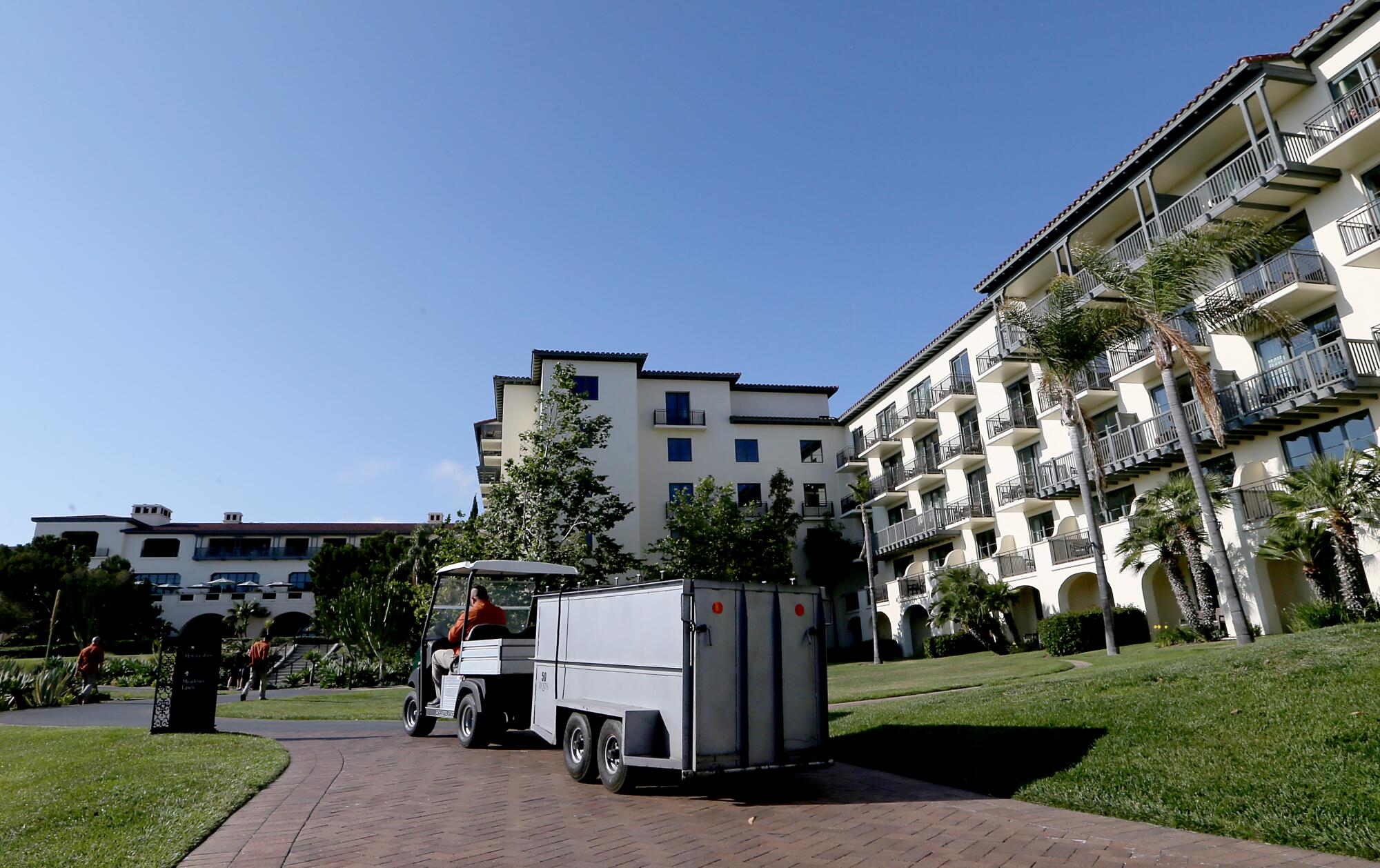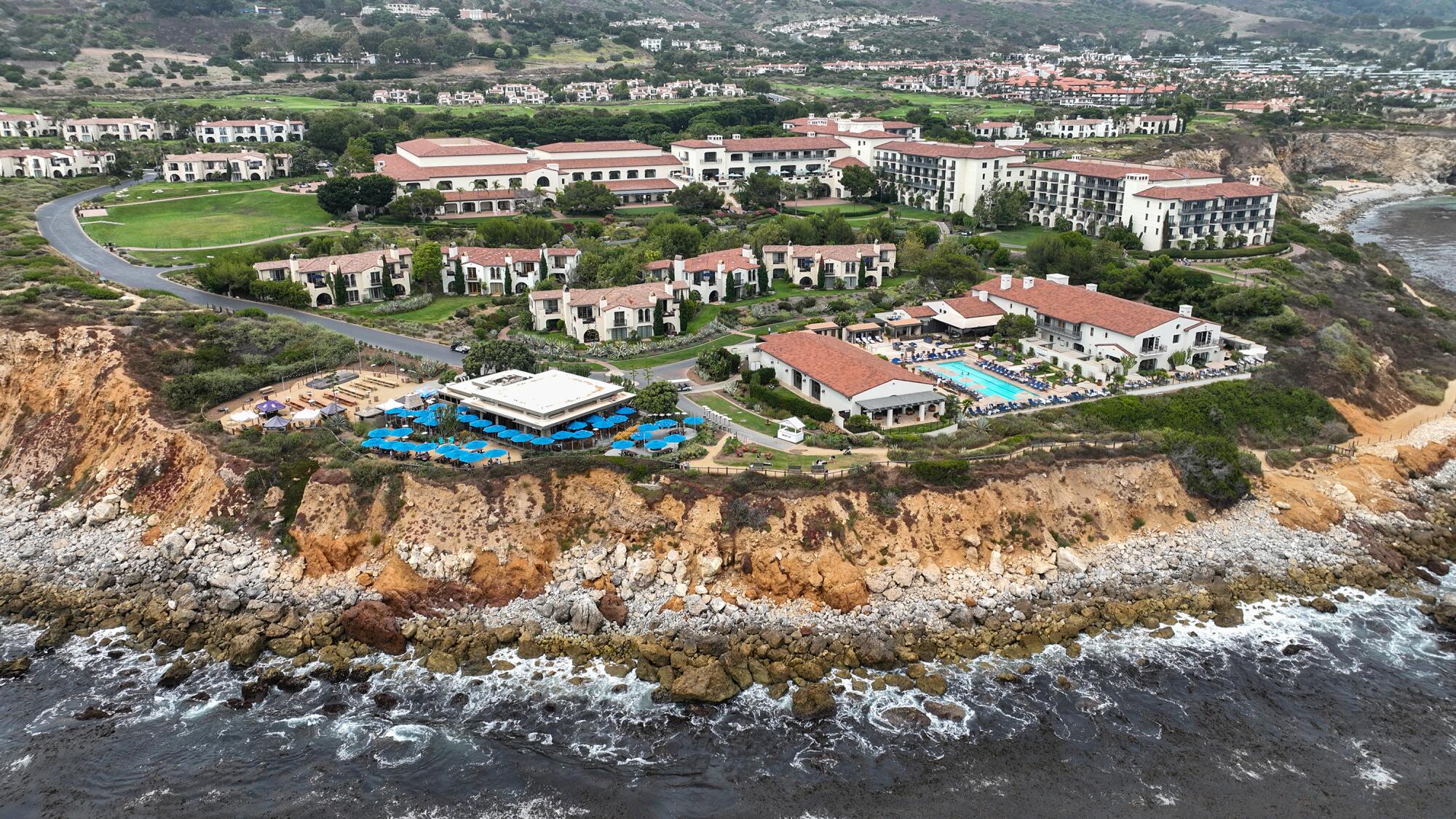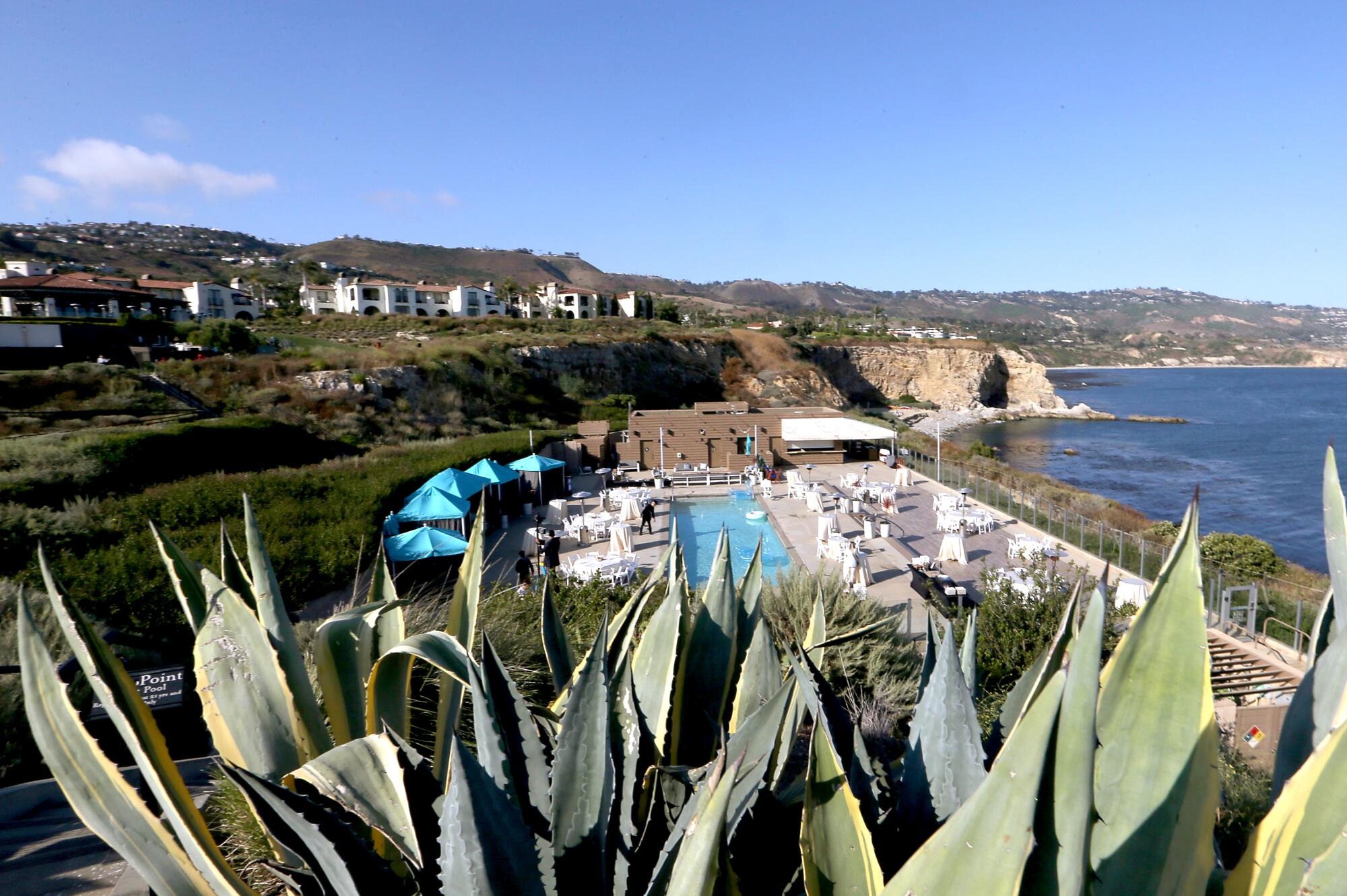- Share via
Rambling above the rust-colored cliffs of the Palos Verdes Peninsula, Terranea Resort is known for its ocean views, world-ranked spa and villas that can command $3,000 a night or more.
The property is less well known as a gathering spot for federal elected officials and the campaign donors they wine and dine.
But one politician was very familiar with the luxurious resort: former House Speaker Kevin McCarthy. In 2 ½ years, the Bakersfield Republican’s election committees dropped nearly a quarter of a million dollars at Terranea, with most of the money coming from a thinly regulated leadership PAC, a Times investigation has found.
As he exits Congress two months after his historic ouster as speaker, political obituaries tout McCarthy’s skills as a prolific fundraiser on behalf of Republican candidates. Also setting him apart from other congressional leaders was his roughly decade-long pattern of using his Majority Committee PAC to spend lavishly on hotels, private jets and fine dining establishments, according to a Times analysis of campaign finance records on file with the Federal Election Commission.
From 2012 through June, McCarthy’s PAC shelled out more than $1 million on hotels, private air travel and eateries, the FEC records show. That’s more than double the combined total spent by the leadership PACs of the seven other lawmakers who’ve held the top House and Senate positions for their parties during all or part of that period, according to the Times analysis.
Leadership PACs are subject to fewer spending controls than other campaign accounts. In fact, the FEC determined earlier this year that these political action committees are free to use their money on personal expenses without limits. Even before the ruling, good-government advocates complained to the FEC that politicians were using their leadership PACs as personal slush funds to subsidize expensive lifestyles. Now, these advocates fear the problem will grow worse.
“Unfortunately, it’s a little bit of the Wild West,” said Michael Beckel, research director for Issue One, a nonprofit organization that studies the role of money in politics. He said the group has “deep concerns” that politicians could use “leadership PAC funds for their own personal enrichment.”

It is unclear how McCarthy, who announced his retirement Wednesday, will use the funds remaining in his campaign accounts once he departs the House at the end of the year. But he said in a Wall Street Journal op-ed this week that he intends to continue recruiting GOP candidates for elected office.
The Terranea outlays by McCarthy’s leadership PAC totaled about $124,000 over a 2 ½-year stretch ending in 2018, a period during which he served as House majority leader. In the same time, a second McCarthy committee rang up bills of about $116,000 at the hotel compound. Combined, the $240,000 pencils out to an average of $8,000 a month.
The McCarthy committees made 20 payments to Terranea in the 2 ½ years ranging from less than $540 to more than $68,000. Most of the expenditures were listed under the category of “lodging,” and 11 were in even-numbered amounts, such as $7,500 and $10,000. The reports did not explain why those amounts were in round dollars.
The FEC does not require politicians to disclose on the finance reports many details of such spending beyond the recipient, date, amount and general category of the expense. McCarthy’s records do not say who stayed or dined at Terranea courtesy of the committees, and there are no breakdowns for how much the PAC spent per night for a room, and nothing about what type of rooms, or how many, were rented. The records offer few clues as to whether the spending was in connection with specific fundraising events or any other campaign activities.
Over the last two months, The Times sent interview requests to McCarthy through his office and campaign organization and submitted a list of detailed written questions about spending by his committees. The congressman did not grant an interview, but after follow-up queries, a McCarthy spokesperson replied in writing that the Terranea costs were for “our annual event” at the resort.
“Expenses were for lodging, catering, event room rentals associated with the PAC retreat,” the spokesperson, Drew Florio, wrote.
Florio did not say when the retreat was held or whether there was more than one such event. He did not answer when asked how many people attended and for specific breakdowns of the costs. Nor did he not answer queries about other expenses, including those incurred at businesses other than Terranea.
Beckel said the lack of details from McCarthy’s camp is a prime example of how “the FEC has abdicated” its authority to ensure in a transparent way that campaign money is used only for campaigns.
In general, dollar totals taken from the FEC filings can be somewhat imprecise or misleading because they are self-reported by officeholders and different labels might be applied to the same types of spending; one politician could report a restaurant expense under “meals,” while another could list it as a “meeting” cost. Duplicate entries for spending or contributions as well as other errors also find their way into the records.
Leadership PACs established by individual elected officials traditionally are used to raise money for other officeholders or candidates. The contributions the McCarthy PAC has given to other Republican House members helped him garner the goodwill and votes to be elected speaker. In the 2021-22 election cycle, as he campaigned for the position, the PAC spent more than $5 million, mostly in contributions that benefited GOP colleagues, the records show.

From 2012 through June, McCarthy’s leadership committee raised more than $26 million and spent about $14.7 million on contributions to GOP candidates and other committees, according to The Times’ analysis. FEC rules cap annual donations to leadership PACs at $5,000 per contributor. The records show that large sums of money came from corporations and organizations such as Native American tribes, but many other donations came from individuals, including corporate executives, venture capitalists, attorneys, consultants, farmers and retirees.
There are straightforward rules for how money from nonleadership campaign committees may be spent — and penalties for breaking them. Siphoning off dollars for personal use from campaign accounts that are not leadership PACs is illegal, and violations have led to criminal convictions of former members of Congress, among them Duncan Hunter, a San Diego County Republican. Last week, former Rep. George Santos (R-N.Y.) was expelled from Congress after House investigators determined that he spent tens of thousands of campaign dollars on rent, a sexually explicit website, Botox and luxury goods.
But the regulations for leadership PACs have been ill-defined since the FEC authorized the committees in the late 1970s. Critics contend that the prohibition on personal use of campaign money — outlined under the federal Election Campaign Act — also applies to the leadership committees, but they have been unable to persuade a majority of the FEC to take that position.
In its decision last winter, the FEC ruled 4 to 2 that nothing in the law bars politicians from using leadership PAC money for personal expenses. The decision resulted from a complaint that a leadership PAC for former House member Lou Barletta (R-Pa.) had paid his wife $33,000 in rent for a property that he owns with her.
The FEC called on Congress to rein in leadership PACs. But Congress has yet to demonstrate any willingness to do so.
Saurav Ghosh, director of federal campaign finance reform for the Washington-based Campaign Legal Center, a nonprofit organization whose mission includes advocating for transparency in election spending, said the FEC essentially punted the issue.
Asked whether the rules are so lax that a politician could buy a personal home with leadership PAC money, Ghosh initially hesitated, saying, “You don’t want to tempt the devil” because “it would be so outrageous.”
He said that while he believed the federal Election Campaign Act should prohibit such a purchase, the FEC has signaled it would not enforce the law in that circumstance. “They’ve really opened the door to abuse, and it’s tough to close it again,” Ghosh said.
Analyses of FEC records by Issue One and the Campaign Legal Center have found that many leadership PACs direct only a fraction of their funds to candidate contributions while spending on high-end hotels, steakhouses, country clubs and ski resorts. The money for those non-contribution expenses comes from donations to the leadership PACs, including from special interests hoping to influence the votes of the elected officials.
McCarthy’s tab at Terranea is not the largest for a leadership PAC at a single fancy venue. For example, in the last decade, a PAC for Sen. John Thune (R-S.D.) spent about $805,000 at the Greenbrier Sporting Club in West Virginia, a favorite spot for GOP retreats, FEC records show.
It’s hard to overstate how much McCarthy’s leadership PAC has outspent those of other congressional leaders on hotels, meals and private jets. For example, the leadership PAC controlled by Rep. Nancy Pelosi (D-San Francisco), whom McCarthy succeeded as speaker, spent a total of about $17,000 in those three categories from 2012 through June, compared with McCarthy’s $1 million-plus, according to The Times’ analysis.
Apart from Pelosi, the rounded-off spending totals in that time for hotels, meals and private jets for the other leaders were: Senate Majority Leader Charles E. Schumer (D-N.Y.), $106,000; Senate Minority Leader Mitch McConnell (R-Ky.), $48,000; House Minority Leader Hakeem Jeffries (D-N.Y.), $16,000; former Speakers John A. Boehner (R-Ohio) and Paul D. Ryan (R-Wis.), $85,000 and $76,000, respectively; and former Senate Majority Leader Harry Reid (D-Nev.), $87,000. Boehner, Ryan, Reid and Jeffries were in office for only part of the period the Times analysis covered. (The leadership PAC for current House Speaker Mike Johnson, the Louisiana Republican who attained the top job after the period The Times examined, spent $27,000 on lodging from the start of his House tenure in 2017 through June.)
In a broader examination of campaign finance records, Pelosi gave McCarthy a run for his money in private jet bills; she’s spent $673,000 on them since 2020. But she did so through her campaign committee, not her leadership PAC, meaning none of the travel could be for personal reasons under the law.
A spokesperson for Pelosi said the congresswoman had no comment on her private jet spending.
::
McCarthy’s spending at Terranea Resort particularly stands out among the current and former congressional leaders because so much of the money has been reported as going toward lodging. And there’s no indication in the FEC filings why the Terranea expenses were heavy during the 2015-18 period and then stopped, although one McCarthy campaign committee reported about $470 in meal expenses there last year.
Terranea is about 140 miles by road from McCarthy’s Bakersfield district office and a bit off the beaten path for federal candidates and lawmakers, with FEC records showing that 17 committees have spent money there since 2012, three of them McCarthy’s. The same is true for the two Pismo Beach properties — Dolphin Bay Resort and Spa and the Cliffs Hotel and Spa — where the McCarthy PAC spent a combined $53,000, in addition to about $5,600 on “beverages” at wineries in the region, according to the FEC records. The expenses at Dolphin Bay and the Cliffs came in the years and months before McCarthy began shipping big money down the coast to the pricier Terranea.

Terranea resort occupies more than 102 acres of the Palos Verdes Peninsula, the former site of the Marineland of the Pacific oceanarium, which closed after more than three decades in 1987. Terranea opened in 2009, and bills itself as a “one-of-a-kind” seaside destination. The 360-room hotel includes a 2,200-square-foot suite, as well as 50 casitas, 32 villas and 20 bungalows.
There are eight restaurants and cafes, a 50,000-square-foot spa and fitness center and a nine-hole golf course. Not far down the road is the 18-hole Trump National Golf Club. The McCarthy committees’ significant spending at Terranea began in December 2015, when it reported about $7,500 in lodging expenses. Its largest single payment just for lodging at the resort was about $40,000, which was reported in May 2018.
Seven of the leadership PAC’s 13 payments to Terranea were in even amounts, which is unusual for hotel expenses by the PACs examined by The Times. Florio, the McCarthy spokesman, did not respond to a request to explain those amounts.
Of the $116,000 the congressman’s other committee — the McCarthy Victory Fund — spent at the resort in the 2 ½ years, the largest amount, $68,000, was reported as catering and lodging costs. Four payments were in even amounts, interspersed among those made by his leadership PAC.
The Victory Fund is a joint fundraising committee of McCarthy’s campaign committee, his leadership PAC and the National Republican Congressional Committee.
The burst of Terranea spending began about a year and a half after McCarthy’s wife, Judy, began working for the California Republican Party as a contact for high-dollar donors. She was paid about $57,000 last year, according to GOP spending records.

Florio, McCarthy’s campaign spokesman, said in his email to The Times that none of the Terranea expenses was related to Judy McCarthy’s GOP role and that she was at the resort “as Congressman McCarthy’s spouse.”
In an illustration of how campaign cash can appear to circulate through the system, Robert J. Lowe, founder of the company that developed Terranea, has given thousands of dollars to McCarthy’s campaign committee and leadership PAC.
Lowe did not respond to interview requests made through his corporate office.
The Times spoke to several former Terranea employees who worked at the resort during the time of McCarthy’s big expenses. Most said they did not recall seeing him on the premises, although they acknowledged they might not have recognized him. Two said they remembered seeing him once or twice at the most, including at what appeared to be a GOP dinner.
One Terranea visitor was Kym Showers, who has identified herself on social media as McCarthy’s cousin and has been pictured in Instagram posts with him at a number of gatherings, including at the U.S. Capitol and White House. In July 2016, Showers, who runs a life coaching business, is seen on Instagram in a poolside photo at Terranea, with the caption, “blue skies & drinks with umbrellas. all day.”
Florio wrote that the McCarthy “committee did not pay for Ms. Showers’ visit.” The Times received no response to a message left for Showers at a phone number listed in her name.
::
It’s not unusual for congressional leaders to travel outside Washington or their districts to raise money and otherwise support candidates from their party. But the McCarthy leadership PAC has spent an outsized amount on private flights rather than on commercial airlines. From 2012 through June, the McCarthy PAC was alone among those for the eight lawmakers to hold the top jobs in the House and Senate to spend substantial amounts in leadership PAC funds on private flying, the Times analysis found.
The PAC racked up more than $560,000 in private jet costs from 2012 to 2015, mostly through Golden State Air Charter. In the years when McCarthy was a regular customer, Golden State boasted of offering “the ultimate luxury in private jet travel.”
McCarthy’s Victory Fund and his campaign committee had about $335,000 in private flying expenses from 2012 through 2016, on top of his leadership PAC bills for such flights.
Back on the ground in Bakersfield, McCarthy is known to dine at Luigi’s, a downtown mainstay. His leadership PAC spent $380 there from 2012 through June. The PAC has had a bigger appetite for restaurants far from his district.

At the Capital Grille in Washington, the committee has forked over more than $20,000 for meals from 2012 through June. The restaurant’s menu features a “porcini-rubbed bone-in ribeye with 15-year aged balsamic” for $84.
Other meal costs were reported as catering expenses. McCarthy again greatly outspent his counterparts in congressional leadership. In the 2 ½-year period, he spent about $700,000 on catering. That includes some $110,000 dropped at Joe’s Seafood, Prime Steak & Stone Crab in the nation’s capital from February 2020 to March. The second largest amount in the overall catering category — more than $390,000 — was by Boehner’s PAC.
It’s no surprise that Boehner would place high on a spending list. Before he retired from Congress, he was known for his extensive use of leadership PAC dollars, logging more than $760,000 in bills for hotels, restaurants and private flights from 2006 through 2015, his last 10 years in office.
He also liked to throw the PAC’s money at golf, charging the committee for $283,000 in green fees and golf course meals in that time.
Ghosh, the Campaign Legal Center director, said the looseness of the rules for leadership PACs, and the spending on upscale restaurants, hotels and golf clubs they allow, can be hard to believe. “When you look at it, at a commonsense level, you say, ‘This can’t possibly be right.’” he said. “It’s low-hanging fruit when it comes to campaign finance reform.”
George LeVines, deputy director for data and graphics, and Iris Lee, assistant editor for data and graphics, contributed to this report.
More to Read
Sign up for Essential California
The most important California stories and recommendations in your inbox every morning.
You may occasionally receive promotional content from the Los Angeles Times.












